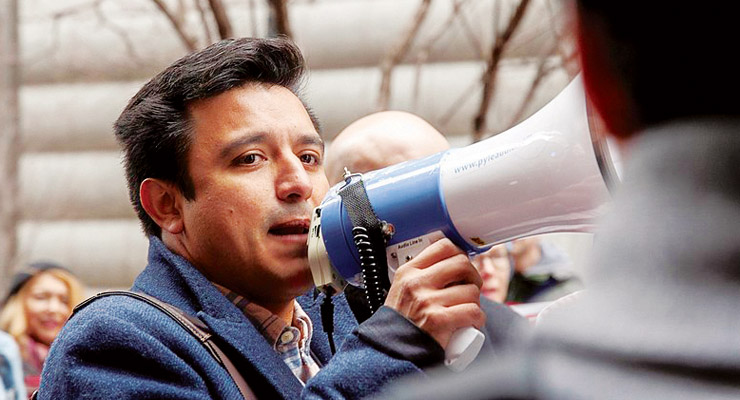By Madeline Makoul
To curb predatory tactics in gentrifying neighborhoods such as Pilsen, the Chicago City Council recently enacted an ordinance imposing fines ranging from $2,000 to $10,000 on real estate developers for repeatedly contacting homeowners who do not want to sell their homes.
The ordinance states developers and real estate investors may not contact homeowners again within a 180-day period, whether such contact occurs by email, phone, mail, or in person. This requirement allows homeowners to report repeated cases of harassment by developers seeking to purchase their homes, enabling their local alderman to investigate the matter.

Alderman Byron Sigcho-Lopez, taking to the streets to protest a new development.
Alderman Byron Sigcho-Lopez, an ordinance sponsor, said homeowners have been receiving stacks of mail, calls, and even visits from developers looking to buy their homes, creating pressure on longtime residents to sell.
“The ordinance protects those who feel harassed or continue to receive mail or unsolicited calls so they can report it, and each alderman can receive complaints of this nature,” Sigcho-Lopez said. “We can investigate, and there are fines associated with this. We can let residents breathe.”
Sigcho-Lopez said that, with high property taxes and home prices skyrocketing in areas across the city (including his 25th Ward), residents already find it difficult to maintain their homes, and added pressure from real estate developers compounds the challenge.
“I want to make sure we have good practices,” Sigcho-Lopez said. “We don’t control who buys and sells, but we want to be sure that, if homeowners sell, it’s on their own terms.”
With the ordinance, Sigcho-Lopez said he already has seen resident complaints about harassing developer tactics decrease because developers do not want to rack up fines.
Next steps
While homeowners have seen some results from the ordinance, Sigcho-Lopez said this legislation is just the start of a series of reforms to address other questionable tactics by developers.
Sigcho-Lopez explained pressure tactics do not stop with phone calls and mail; they escalate to calls to inspectors about possible code violations. As a result, inspectors go to homes and find issues, requiring homeowners to pay thousands of dollars to remain up to code, putting further pressure on them to sell. Such escalation overwhelms residents, particularly seniors who are more susceptible to such schemes, Sigcho-Lopez said.
“What we are saying” with the ordinance “is we aren’t going to allow this here, and we have an administration that is committed to helping and protecting the small homeowners who are already burdened by high property taxes,” Sigcho-Lopez said. “The last thing we want is the City putting even more pressure on them.”
Stacey Sutton, an assistant professor at the University of Illinois at Chicago’s College of Urban Planning and Public Affairs, said that, while neighborhood change is inevitable as gentrification expands south across the city, the implications are disruptive and force the most vulnerable out.
“Again and again, we normalize that, if you have more money, you are allowed to take my home, and that’s what it comes down to. If you have more money, you have more rights, and that’s not okay,” Sutton said.
Sigcho-Lopez said he also wants to create incentives and subsidies so homeowners keep their homes, even as repairs and property taxes mount. Support would include helping people appeal their taxes, something he said many seniors and others may not know they have the option to do.
Sigcho-Lopez stressed the importance of awareness that housing stock in Pilsen and other communities in this area often is old, making repairs even more challenging and costly. He said the City can alleviate this burden with tax freezes, funding through the City of Chicago Neighborhood Opportunity Fund or tax increment financing (TIFs), and grants for those looking to repair buildings.
“This ordinance is a preventive measure,” he explained. “People feel suffocated, and we wanted to give them some relief. Now, we should be thinking about how we can help them. We want to keep the social fabric of the community. Change is a constant of life, but what is happening here isn’t organic change.”
Bracing for change
With neighborhoods across the City of Chicago evolving, new buildings popping up, and an influx of new residents, the social fabric is changing, too.
Change displaces residents, Sutton explained. It favors those with money and pushes current residents out, and those who are displaced end up moving from neighborhood to neighborhood as gentrification continues to spread, creating “domestic refugees.” This process disrupts the sense of community and security in neighborhoods, pushing out lower income families.
“Neighborhood change is inevitable,” Sutton said. “But when I talk about gentrification, I’m talking about the displacement of residents, I’m talking about the land values going up so that those who have been there awhile can no longer stay, or they feel socially excluded from the area. But that doesn’t have to happen. That’s where policy can come in and mitigate some of those pressures.”
Nathan Ryan, director of communications at Grassroots Collaborative, said affordable housing forms a key part of preventing the negative impacts of gentrification. Both Ryan and Sigcho-Lopez cited a mounting need for affordable housing in new developments. Sigcho-Lopez wants more transparency with new developments to ensure they provide more afford-
able units.
Ryan explained that developer have abused TIFs in relation to affordable housing and new developments. Originally set up to help low-income communities, developers have “hijacked” TIFs to get subsidies in areas they plan to develop.
“This doesn’t only hurt our property tax base, but it hurts our education system and contributes to the gentrification and displacement we are seeing throughout the city,” Ryan said. “Gentrification is part of a larger story of how Chicago has failed our economic development, especially economic development for people of color.”
Ultimately, Sigcho-Lopez wants more “conscious development.” He said setting aside affordable housing that is “fair” will help balance development with affordability and allow more low-income families to remain in their local neighborhood.
“Diverse communities have young people, they have families, they have small and big businesses,” Sigcho-Lopez said. “Diverse communities that are based in solidarity thrive—that’s sustainable. When [developers] are building just to make quick money, no one is really investing in the community.”
Visit Alderman Sigcho-Lopez’s website at 25thward.org or call (773) 523-4100. For more on Grassroots Collaborative, visit their site at grassrootscollaborative.org, or email [email protected].












